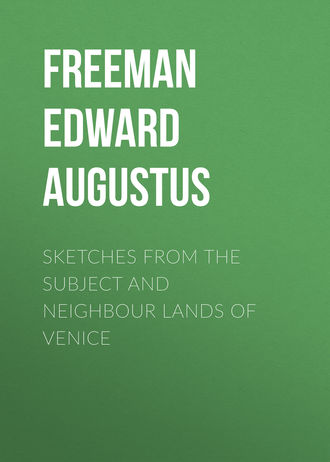
Freeman Edward Augustus
Sketches from the Subject and Neighbour Lands of Venice
We are now fairly in the town. The best way to see Curzola thoroughly is for the traveller to make his way how he will to the ridge of the peninsula, and then systematically to visit the steep and narrow streets, going in regular order down one and up another. There is not one which does not contain some bit of domestic architecture which is well worth looking at. But he should first walk along the ridge itself from the gate by the isthmus to the point where the ground begins to slope to the sea opposite Sabioncello. Hard by the gate is the town-hall, Obcina, as it is now marked in the native speech. The mixed style – most likely of the seventeenth century – of these parts comes out here in its fulness. Columns and round arches which would satisfy any reasonable Romanesque ideal, support square windows which are relieved from ugliness by a slight moulding, the dentel – akin to our Romanesque billet – which is seen everywhere. But in a projecting building, which is clearly of a piece with the rest, columns with nondescript capitals support pointed arches. Opposite to the town-hall is one of the smaller churches, most of which are of but little importance. This one bears the name of Saint Michael, and is said to have formerly been dedicated to Orthodox worship. It shows however no sign of such use, unless we are to count the presence of a little cupola over the altar. We pass along the ridge, by a house where the projection for balconies, so abundant everywhere, puts on a specially artistic shape, being wrought into various forms, human and animal. Opposite the cathedral the houses display some characteristic forms of the local style, and we get more fully familiar with them, as we plunge into the steep streets, following the regular order which has been already prescribed. Some graceful scrap meets us at every step; the pity is that the streets are so narrow that it needs some straining of the neck to see those windows which are set at all high in the walls. For it is chiefly windows which we light upon: very little care seems to have been bestowed on the doorways. A square or segmental-headed doorway, with no attempt at ornament, was thought quite enough for a house for whose windows the finest work of the style was not deemed too good. Indeed the contrasts are so odd that, in the finest house in Curzola, in one of the streets leading down eastward from the cathedral, a central story for which magnificent would not be too strong a word is placed between these simple doorways below and no less simple square-headed windows above. This is one of the few houses in Curzola where the windows are double or triple divided by shafts. Most of the windows are of a single light, with a pointed, an ogee, or even a round head, but always, we think, with the eminently Venetian trefoil, and with the jambs treated as a kind of pilaster. With windows of this kind the town of Curzola is thick-set in every quarter. We may be sure that there is nothing older than the Venetian occupation, and that most of the houses are of quite late date, of the sixteenth and even the seventeenth century. The Venetian style clave to mediæval forms of window long after the Renaissance had fully set in in everything else. And for an obvious reason; whatever attractions the Renaissance might have from any other point of view, in the matter of windows at least it hopelessly failed. In the streets of Curzola therefore we meet with an endless store of windows, but with little else. Yet here and there there are other details. The visitor will certainly be sent to see a door-knocker in a house in one of the streets on the western slope. There Daniel between two lions is represented in fine bronze work. And some Venetian effigies, which would doubtless prove something for local history, may be seen in the same court. Of the houses in Curzola not a few are roofless; not a few have their rich windows blocked; not a few stand open for the visitor to see their simple inside arrangements. The town can still make some show on a day of festival; but it is plain that the wealth and life of Curzola passed away when it ceased to be the arsenal of Venice. And poverty has one incidental advantage; it lets things fall to ruin, but it does not improve or restore.
Two monasteries may be seen within an easy distance of the town. That of Saint Nicolas, approached by a short walk along the shore to the north-west, makes rather an imposing feature in the general view from the sea; but it is disappointing when we come near. Yet it illustrates some of the local tendencies; a very late building, as it clearly is, it still keeps some traces of earlier ideas. Two equal bodies, each with a pointed barrel-vault, might remind us of some districts of our own island, and, with nothing else that can be called mediæval detail, the round window does not fail to appear. The other monastery, best known as the Badia, once a house of Benedictines, afterwards of Franciscans, stands on a separate island, approached by a pleasant sail. The church has not much more to show than the other; but it too illustrates the prevalent mixture of styles which comes out very instructively in the cloister. This bears date 1477, as appears from an inscription over one of its doors. But this doorway is flat-headed and has lost all mediæval character, while the cloister itself is a graceful design with columns and trefoil arches, which in other lands one would attribute to a much earlier date. The library contains some early printed books and some Greek manuscripts, none seemingly of any great intrinsic value. A manuscript of Dionysios Periêgêtês is described as the property of the Korkyraian Nicolas and his friends. (Νικολάου Κερκυραίου καὶ τῶν φίλων.) Nicolas had a surname, but unluckily it has passed away from our memory and from our notes. But the local description which he has given of himself makes us ask, Did the book come from Corfu, or did any citizen of Black Korkyra think it had a learned look so to describe himself?
On the staircase of the little inn at Curzola still hangs a print of the taking of the arsenal of Venice by the patriots of 1848. Strange that no Imperial, Royal, and Apostolic official has taken away so speaking a memorial of a deed which those who commemorate it would doubtless be glad to follow.
RAGUSA
1875 – 1877 – 1881
The voyage onward from Curzola will lead, as its next natural stopping-place, to Ragusa. At Curzola, or before he reaches Curzola, the traveller will have made acquaintance with what was once the territory of the Ragusan commonwealth, in the shape of the long peninsula of Sabioncello. He will have seen how all the winged lions of Curzola look out so threateningly towards the narrow tongue of land which bowed to Saint Blaise and not to Saint Mark. He will pass by Meleda, that one among the larger islands which obeyed Ragusan and not Venetian rule. After Meleda the islands cease to be the most important features in the geography or in the prospect. They end, so far as they give any character to the scene, in the group which lies off the mouth of the inlet of Gravosa and Ombla, the ordinary path to Ragusa. But he who would really take in the peculiar position of Ragusa will do well to pass by the city on his outward voyage, to go on to Cattaro, and to take Ragusa on the way back. The wisdom of so doing springs directly out of the history of the city. The haven, which is said – and we have no better derivation to suggest – to have given its name to argosies, could certainly not give shelter to a modern argosy. Nothing but smaller craft now make their way to Ragusa herself; steamers and everything else stop at the port of Gravosa. It has been only quite lately, long since the earlier visits which gave birth to the present sketches, that Ragusan enterprise has so far again awakened as to send a single steamer at long intervals from the true Ragusan haven to Trieste. He therefore who visits Ragusa on his outward voyage has to land at Gravosa and to make his way to Ragusa by land. He thus loses the first sight of the city from the sea which he has had at Zara and Spalato, and which at Ragusa is, setting special associations aside, even more striking than at Zara and Spalato. Before he sees Ragusa from the water, as Ragusa was made to be seen, he has already made acquaintance with the city in a more prosaic fashion. He will not indeed have had his temper soured by the inconveniences which Sir Gardner Wilkinson had to put up with more than thirty years ago. There is no more delay at the gate of Ragusa, there is no more difficulty in finding a carriage to take the traveller from Gravosa to Ragusa, than there is in the most frequented regions of the West. Still, in such a case, the traveller sees Ragusa for the first time from the land, and Ragusa of all places ought to be seen for the first time from the sea. Seen in this way, the general effect of Ragusa is certainly more striking than that of any other Dalmatian city; and it is so in some measure because the effect of Ragusa, whether looked at with the bodily eye or seen in the pages of its history, is above all things a general effect. There is not, as there is at Zara and at Spalato, any particular moment in the history of the city, any particular object in the city itself, which stands out prominently above all others. We draw near to Zara, and say, "There is the city that was stormed by the Crusaders," and, though we find much at Zara to awaken interest on other grounds, the crusading siege still remains the first thing. We draw near to Spalato; we see the palace and the campanile, and round the palace and the campanile everything gathers. We draw near to Ragusa; the eye is struck by no such prominent object; the memory seizes on no such prominent fact. But there is Ragusa; there is the one spot along that whole coast from the Croatian border to Cape Tainaros itself, which never came under the dominion either of the Venetian or of the Turk. Ragusa will be found at different times standing in something like a tributary or dependent relation to both those powers, but it never was actually incorporated with the dominions of either. In this Ragusa stands alone among the cities of the whole coast, Dalmatian, Albanian, and Greek. Among all the endless confusions and fluctuations of power in those regions, Ragusa stands alone as having ever kept its place, always as a separate, commonly as an independent, commonwealth. It lived on from the break-up of the Byzantine power on those coasts till the day when the elder Buonaparte, in the mere caprice of tyranny, without provocation of any kind, declared one day that the Republic of Ragusa had ceased to exist. This is the history of Ragusa, a history whose general effect is as striking as any history can be. It is a history too which, if we dig into its minute details, is full of exciting incidents, but not of incidents which, like the one incident in the history of Zara, stand out in the general history of Europe. There is, to be sure, one incident in Ragusan history which may claim some attention at the hands of Englishmen, and ought to claim more at the hands of Poitevins. Count Richard of Poitou, who was also by a kind of accident King of England, and who in the course of his reign paid England two very short visits, paid also a visit to Ragusa which was perhaps still shorter. But this again is an incident of mere curiosity. The homeward voyage and captivity of Richard had some effect on the general affairs of the world; his special visit to Ragusa affected only the local affairs of Ragusa. Ragusan history then may either be taken in at a glance, and a most striking glance it is; or else it may be studied with the minute zeal of a local antiquary. There is no intermediate point from which it can be looked at. In the general history of Europe Ragusa stands out, as the city itself stands out to the eye of the traveller, as that one among the famous cities of the Dalmatian and Albanian coast where the Lion of Saint Mark is not to be seen.
As is the history, so is the general effect. As we sail past Ragusa, as we look at the city from any of the several points which the voyage opens to us, we say at once, Here is one of the most striking sights of our whole voyage; but we cannot at once point our finger to any one specially striking object. There are good campaniles, but there is nothing very special about them; there are castles and towers in abundance, but each by itself on any other site would be passed by without any special remark. What does call for special remark and special admiration is the city itself, at once rising from the sea and fenced in from the sea by its lofty walls. It is the shore, with its rocks and its small inlets, each rock seized on as the site of a fortress. It is the background of hills, forming themselves a natural rampart, but with the artificial defences carried up and along them to their very crest. Here we are not tempted, as we are tempted at some points of our voyage, to forget that our voyage is one by sea, and to fancy that we are floating gently on some Swiss or Italian lake. Ragusa does not stand on a deep inlet like Cattaro, on a bay like Spalato, on a peninsula like Zara, fenced in by islands on one side and by the opposite shore of its haven on the other. Ragusa does indeed stand on a peninsula, but it is a peninsula of quite another kind; a peninsula of hills and rocks and inlets, offering a bold front to the full force of the open sea. One island indeed, La Croma, lies like a guard-ship anchored in front of the city, but we feel that La Croma is strictly an island of the sea. The islands of the more northern coast form as it were a wall to shelter the coast itself. And such a function seems specially to be laid upon the small islands which lie off the mouth of Ragusa's modern haven at Gravosa. Covered indeed as they are with modern fortifications, it is not merely in a figure that it is laid upon them. But La Croma fills no such function. The city of argosies boldly fronts the sea on which her argosies were to sail, and fiercely do the waves of that sea sometimes dash upon her rocks. Ragusa seems the type of a city which has to struggle with the element on which her life is cast, while Venice is the type of a city which has, in the sense of her own yearly ceremony, brought that element wholly under her dominion.
As we look up from the sea to the mountains, we feel yet more strongly how purely Ragusa was a city of the sea. Venice was an inland power on that Italian land off which she herself lay anchored. She might pass for an inland power even on the Ragusan side of the Hadriatic. The Dalmatian territory of Venice looks on the map like a narrow strip; but, compared with the Ragusan coast, the Venetian coast has a wide Venetian mainland to the back of it. But Ragusa lies at the foot of the mountains, and the crest of the mountains was her boundary. She has always sat on a little ledge of civilization, for four centuries on a little ledge of Christendom, with a measureless background of barbarism behind her. Those hills, the slopes of which begin in the streets of the city, once fenced in a ledge of Hellenic land from the native barbarians of Illyricum. Then they fenced in a ledge of Roman land from the Slavonic invader. Lastly, when we first looked on them, when we first crossed them, they still fenced in a ledge of Christian land from the dominion of the Infidel. And the newest arrangements of diplomacy make it still not wholly impossible to use the language which we used then. The Archduke of Austria and King of Dalmatia is immediate sovereign of Ragusa and her ancient territory; when we cross the line between Ragusa and Herzegovina, he rules only in the character familiar to some even of his Imperial forefathers, that of the man of the Turk. The Christian prince simply "administers;" it is the Infidel Sultan who is still held to reign. To form such a boundary as this has been no mean calling for the heights which look down upon Ragusa. It is well to climb those heights, best of all to climb them by the road which so lately led, which we might almost say still leads, from civilization to barbarism, from Christendom to Islam, and to look down on the city nestling between the sea and the mountains. The view is of the same kind as the view of the city from the sea. Rocks, inlets, walls, and towers, come out in new and varied groupings, but there is still no one prominent object. La Croma indeed, with its fallen monastery – its fortress is not seen – now comes in as a prominent object. But it shows by its very prominence the difference between this part of the Dalmatian coast, with its one island, all but invisible on the map, lying close to the shore, and the two archipelagos, one of small and obscure, one of great and historic islands, which the voyager has already passed by.
It would thus be well if we could look on Ragusa both from the sea and from the mountains before we approach the city by the one possible to reach it, by the road which leads from its port of Gravosa. This last is a picturesque haven of thoroughly Dalmatian character, lying on a smooth inlet with a small fertile fringe between the water and the mountains. The road, rising and falling, looking out on both the mountains and the sea, leads along among villas and chapels which gradually grow into a suburb till we reach the gate. Here we see not a few ruined houses, houses which have remained ruined for nearly seventy years, houses whose ruin was wrought by Montenegrin hands in the days when Ragusa was an unwilling possession of France and Montenegro a valued ally of England. But, before we reach the gate, we see what there was not in the time of Sir Gardner Wilkinson, carriages standing for hire, carriages no very long drive in which will take us over the late borders of Christendom. In that suburb too the traveller will most likely take up his quarters – quarters, it may be, looking down straight on the rocks and waves. And there, when war was raging at no great distance, and when Ragusa was the special centre of the purveyors of news, he was sure to hear both the latest truths and the latest fables. But he is still outside the city. No city brings better home to us than Ragusa the Eastern hyperbole of cities great and fenced up to heaven. We must leave the military architect to discuss their military merits or demerits. To the non-professional observer they seem to belong to that type of fortification, between mediæval and modern, which in these lands we naturally call Venetian, inapplicable as that name is at Ragusa. But they have clearly been strengthened and extended in more modern times. The city lies in a kind of hollow between the lower slopes of the mountain on one side, and a ridge which lies between the mountain and the sea, and which thus adds greatly to the appearance of the fortifications as seen from the sea. The one main street of Ragusa, the Stradone, thus lies in a valley with narrow streets running down towards it on both sides. Indeed, before the great earthquake of 1667 which destroyed so much of old Ragusa, part at least of this wide street was covered with water as a canal. It is so pent in with buildings that we hardly feel how near we are to the sea; yet the small port, the true port of Ragusa, is very near at hand. The two ends of the Stradone are guarded by gates, which lead up – for the ascent is considerable – to the outer gates at either end, still strong and still guarded, reminding us that we are in what is still really a border city. And over those gates we see, not the winged lion for which we have learned to look almost instinctively everywhere on these coasts, but the figure of Saint Blaise, San Biagio, the patron of Ragusa, whose relics form some of the choicest treasures in the rich hoard of her once metropolitan church. We pass under the saintly effigy, and we find that within the walls the general aspect of the city is comparatively modern. Most of the buildings, the metropolitan church among them, were rebuilt after a great earthquake in 1667. Such remains however of old Ragusa as are still left are of such surpassing interest in the history of architecture that we must keep them for a more special examination.
The history of Ragusa, as we have already said, is of a kind which must either be taken in at a glance or else dealt with in the minutest detail. All Dalmatian history for a good many centuries wants a more thorough sifting than has ever been brought to bear upon it. It wants it all the more because it is so closely connected with early Venetian history, than which no history is more utterly untrustworthy. But we may safely gather that Ragusa had its origin in the destruction of the Greek city of Epidauros, now Ragusa Vecchia. The old Epidaurian colony fell, like Salona, before the barbarians. Its inhabitants had no ready-made city to flee to, but they founded a city on the rocks which became Raousion or Ragusa. Whether any part of the Ragusan peninsula had ever become a dwelling-place of men at any earlier time it is needless to inquire. It is enough that Ragusa now became a city. As to the name of the city, our Imperial guide helps us to one of his strange etymologies. With him Epidauros has sunk into Πίταυρα – the t seems to have supplanted the d at a much earlier time – and the city on the rocks which its exiles founded was first called from its site Λαύσιον, which by vulgar use (ἡ κοινὴ συνήθεια, ἡ πολλάκις μεταφθείρουσα τὰ ὀνόματα τῇ ἐναλλαγῇ τῶν γραμμάτων) became Ῥαούσιον. He tells us that, ἐπεὶ ἐπάνω τῶν κρημνῶν ἵσταται, λέγεται δὲ Ῥωμαϊστὶ ὁ κρημνὸς λαῦ, ἐκλήθησαν ἐκ τούτου Λαυσαῖοι, ἤγουν οἱ καθεζόμενοι εἰς τὸν κρημνόν. What tongue is meant by Ῥωμαϊστί? It is only because the strange form λαῦ seems to come one degree nearer to λᾶας ἀναιδής than to anything in Latin, that it dawns on us that it means Greek. But, under whatever name, the city on the rocks, small at first, strengthened by refugees from Salona, grew and prospered, and remained one of the outlying Roman or Greek posts which in the days of Constantine, as now, fringed the already barbarian land.
For some centuries after the time of Constantine Porphyrogenitus, the history of Ragusa defies abridgement. It is one web of intricate complications between the Emperors of the East and West, the Republic of Venice, the Kings of Hungary, Dalmatia, and Bosnia. Somewhat later the story begins to be more intelligible, when the actors get pretty well reduced to Venice, the Turk, and the Empire in a new form, that of Charles the Fifth. The republic of Ragusa contrived, which must surely have needed a good deal of skill, to keep on good terms at once with Charles and his son Philip and with their Turkish enemies. Yet Ragusa, though never incorporated by anything earlier than the dominion of Buonaparte, stood at different times in a kind of dependent relation both to Venice and to the Turk. At an earlier time the commonwealth for a short time received a Venetian Count. He was doubtless only meant to be like a foreign podestà, but Venice was a very dangerous place for Ragusa to bring a podestà from. In her later days Ragusa must be looked on as being under the protection of the Porte; but it was a protection which in no way interfered with her full internal freedom – such freedom at least as is consistent with the rule of an oligarchy. The geography of Dalmatia keeps to this day a curious memorial of the feeling which made Ragusa dread the Turk less than she dreaded Venice. To this day the Dalmatian kingdom does not extend continuously along the Dalmatian coast. At two points territory which till late changes was nominally Turkish, which is still only "administered," not "governed," by its actual ruler, comes down to the Hadriatic coast. These are at Klek, at the bottom of the gulf formed by the long Ragusan peninsula of Sabioncello, and at Sutorina on the Bocche di Cattaro. These two points mark the two ends of the narrow strip of coast which formed the territory of Ragusa. Rather than have a common frontier with Venice at either end, Ragusa willingly allowed the dominions of the Infidel to come down to her own sea on either side of her.
At last all dread from Venice passed away, but only because Saint Mark gave way to a more dangerous neighbour. The base conspiracy of Campoformio gave Venetian Dalmatia to an Austrian master, and the strips of Turkish territory which had once sheltered Ragusa from the Venetian now for a while sheltered her from the Austrian. Then the dividers of the spoil quarrelled; the master of France took to himself what France had betrayed to Austria. Presently he disliked the small oasis of independence, and added Ragusa to the dominion which was presently to take in Rome and Lübeck. Lastly, when the days of confusion were over, and order came back to the world, order at Ragusa took the form of a new foreign master. The Austrian, who had reigned for a moment at Zara and Cattaro, but who had never reigned at Ragusa, put forth his hand to filch Ragusa as he has since filched Spizza. The motive need not be asked. The pleasure of seizing the goods of a weaker neighbour is doubtless enough in either case.
One point in the history of Ragusa which needs a more thorough explanation than it has yet found is the fact that the Roman or Greek city, founded by men who had escaped from barbarian invaders – who must surely have been largely Slavonic – has become so pre-eminently a Slavonic city. There is no Italian party at Ragusa. Not that the city is strongly Panslavonic; the memory of local freedom has survived through both forms of foreign rule. The Ragusan aristocracy is Slavonic, and the Slavonic language holds quite another position at Ragusa from what it holds, for example, at Spalato. There all that claims to be literature and cultivation is Italian; at Ragusa, though Italian is familiarly spoken, the native literature and cultivation is distinctly Slave. The difference is marked in the very names of the two cities. Spalato is in Slavonic Spljet, a mere corruption of the corrupt Latin name. But Ragusa, on Slavonic lips – that is on the lips of its own citizens speaking their own language – is Dubrovnik, a perfectly independent Slavonic name. It may be the name of some Slavonic suburb or neighbouring settlement – like the Wendisches Dorf at Lüneburg – but at all events it is no corruption, no translation, of Latin Ragusa or of Constantine's Raousion.
As for King Richard, the Ragusan story is that he built the cathedral which was destroyed in 1667. It is said that he vowed to build a church on the island of La Croma, and that this purpose was changed into building one in the city instead of the former cathedral, while the commonwealth of Ragusa built a church on the island. La Croma thus becomes connected with the memory of two princes who died of thrusting themselves in matters which did not concern them. Richard, Count and King, might have lived longer if he had not quarrelled with his vassal at Limoges; Maximilian, Archduke and self-styled Emperor, was perfectly safe at La Croma, but when he took up the trade of a party-leader in Mexico, he could hardly look for anything but a Mexican party-leader's end. Of the monastery which formed his dwelling-place the great church is so utterly desecrated and spoiled that hardly anything can be made out. But a good deal remains of the cloister, and at a little distance stand the ruins of a beautiful little triapsidal basilica, which surely, all save a few additions, belongs to the age of the Lion-hearted King. Indeed we should be tempted to fix on this, rather than any other church of Ragusa or its island, as the work of Richard himself. It looks greatly as if a Count of Poitiers and Duke of Aquitaine had had a hand in it. A single wide body, with three apses opening into it, is not a Dalmatian idea, as it is not an English idea. But something like it might easily be found in Richard's own land of southern Gaul.
That Richard did come to Ragusa and to La Croma seems plain from the narrative in Roger of Howden. He hired a ship at Corfu expressly to take him to Ragusa. He landed "prope Gazere apud Ragusam." Gazere suggests Jadera or Zara, but "Gazere apud Ragusam" can hardly fail to mean La Croma. "Gazere" is the Arabic name for island– the same which appears in Algesiras– one of the Eastern words which passed into the lingua franca of the Crusaders. After all, Ragusa gives more interest to Richard than any that it takes from him. Born and twice crowned in England, he had little else to do with England than to squeeze money out of it. It mattered little to Englishmen – or to Normans either – whether their Poitevin lord was astounding the world at Acre, at Chaluz, or at La Croma.
Two other rather longer excursions than that to La Croma may be profitably made from Ragusa. There is, first of all, the short voyage to the site of the city which Ragusa supplanted, the Dalmatian Epidauros, now known by the odd name of Ragusa Vecchia. Beyond a few inscriptions, there is really next to nothing to be seen of the ancient city besides its site; but the site is well worthy of study. It is thoroughly the site for a Greek colony, and it has much in common with the more famous site of Korkyra and Epidamnos. The city occupied a peninsula, sheltered on the one hand by the mainland, on the other by another promontory, forming the outer horn of a small bay. In this position the town had the sea on every side; it had a double harbour, and was at the same time thoroughly sheltered on both sides. Such a site was the perfection of Greek colonial ideas. We have now got far away indeed from the earliest type of city – the hill-fort which dreads the sea, and which finds the need of the haven, and of the long walls to join the haven to the city, only in later times. The highest point of the promontory, the akropolis – if we can use that name in a city of such late date – is now forsaken, crowned only by a burying-ground and sepulchral church. The view is a noble one, looking out on the mainland and the sea, with the neighbouring island crowned by a forsaken monastery, and directly in front Ragusa herself on her rocks, with the beginnings of the Dalmatian archipelago rising in the distance. The modern town, which is hardly more than a village, with two or three churches and a small amount of fortification, covers the isthmus and the lower ground of the promontory. Such is all that is left of the northern city of Asklêpios, the city which played its part alike in the wars of Cæsar and in the wars of Belisarius, which in the great revolution that followed the Slavonic inroads perished to give birth to the more abiding city from which it has strangely borrowed its later name. That Ragusa Vecchia has so little to show is no ground for despising it or passing it by; the very lack of remains in some sort adds to the interest of the spot.







